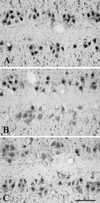Brain-derived neurotrophic factor regulates expression of androgen receptors in perineal motoneurons
- PMID: 9037086
- PMCID: PMC19824
- DOI: 10.1073/pnas.94.4.1521
Brain-derived neurotrophic factor regulates expression of androgen receptors in perineal motoneurons
Abstract
Motoneurons in the spinal nucleus of the bulbocavernosus (SNB) express androgen receptors and innervate striated muscles attached to the penis. Previous studies indicated that androgen receptor immunoreactivity in the SNB motoneurons decreases after axotomy and returns to normal only in motoneurons allowed to reinnervate their muscle targets, suggesting that neuron-target interactions play a role in regulating steroid receptor expression in the central nervous system. This study demonstrates that (i) silencing the SNB neuromuscular system with tetrodotoxin did not affect androgen receptor expression in these motoneurons, suggesting that the regulation of androgen receptor is activity-independent; (ii) disruption of axonal transport with vinblastine caused a down-regulation of androgen receptor expression in the SNB motoneurons; and (iii) treatment with brain-derived neurotrophic factor, but not ciliary neurotrophic factor, neurotrophin-4, or glial cell line-derived neurotrophic factor, reversed the axotomy-induced down-regulation of androgen receptor expression. These findings demonstrate neurotrophin regulation of steroid receptor expression in the central nervous system in vivo.
Figures





References
-
- Arnold A P, Jordan C L. In: Frontiers of Neuroendocrinology. Martini L, Ganong W F, editors. Vol. 10. New York: Raven; 1988. pp. 185–214.
-
- Arnold A P. In: Hormones, Brain and Behavior in Vertebrates. Balthazart J, editor. Basel: Karger; 1990. pp. 82–91.
-
- Jones K J. Ann NY Acad Sci. 1994;743:141–164. - PubMed
-
- Davies A M. Nature (London) 1994;368:193–194. - PubMed
-
- Lindsay R M. Neurobiol Aging. 1994;15:249–251. - PubMed
Publication types
MeSH terms
Substances
Grants and funding
LinkOut - more resources
Full Text Sources

